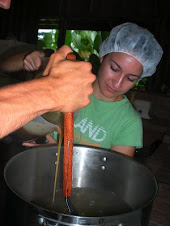Identifying trees is tougher than identifying short shrubby plants! I went out today identifying trees with Roberto. To properly id a tree, it’s necessary to inspect the leaves, but since I cannot reach them by hand (canopy trees can be up to 20 meters tall) I had to use binoculars. I am not a fan of using binoculars and even using them for stationary objects, like leaves, is dizzying for me. I had to lie down on the ground and point the binoculars upwards, all the while being wary of being bitten by ants. And it's especially difficult to id trees in the rainforest since various trees are crowded together and leafy vines are growing on everything, making it confusing to figure out which leaf belongs to which plant. After spending half an hour identifying an Inga tree in the Fabaceae family (bean family), I narrowed it down to four possible species. Now I just need to wait until it's flowering or fruiting to be able to pin down the species.
I’m also fermenting cacao pods to make chocolate! We got 25 cacao pods from our cacao field. Using his machete, Fernando helped hack open the pods and I spread out the sweet mucilaginous beans onto a straw mat placed at the bottom of a drum container cut vertically in half. I then marched out in the garden, armed with a heavy kitchen knife, and retrieved a few banana leaves to cover the beans so they can ferment in the dark.
Also, funny side note speaking of chocolate. In the morning, after seeing Fernando make himself some chocolate milk using fresh milk, I really wanted a glass for myself. Later in the day I went down to the pool kitchen, where we keep our milk, and filled a little pitcher with a bit of milk. Once back at the main kitchen I set to work mixing in some sugar and cocoa powder. It was the richest chocolate milk I had ever tasted. In the morning I found out that the milk that I used to make my chocolate milk was not cow’s milk but buffalo milk! No wonder it was so creamy! Buffalo milk has a much higher fat content than cow’s milk, which makes it ideal for thick yogurts, cheeses, and butters.
Monday, November 3, 2008
Subscribe to:
Post Comments (Atom)







No comments:
Post a Comment